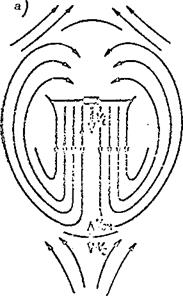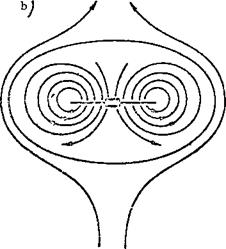Helicopter Vertical Descent With Operating Engine
Helicopter flight downward along a vertical trajectory is termed the vertical descent regime. In this case the following forces act on the helicopter (Figure 57): the helicopter weight G, main rotor thrust force T, and
tail rotor thrust T.
t. r
|
|
|

EM = 0. eg
Here we must bear in mind that
we neglect the parasite drag force in view of its small magnitude, and we assume that as a result of the small tilt of the cone axis to the side TTaY.
In transitioning from the hovering regime to the vertical descent regime, the main rotor pitch must be decreased and in so doing the main rotor thrust force is also reduced. However, as soon as the helicopter transitions into descent the blade element angles of attack increase, which leads to increase of the thrust force to the value present prior to reducing the pitch. Thus, the condition T.= G holds for both hovering and vertical descent.
The power required for vertical descent is defined just as in the other vertical regimes
![]() = N. + N
= N. + N
pr
i. e., it is equal to the sum of the induced and profile powers. At constant rpm the profile power is practically independent of main rotor pitch, consequently N = N. The induced power in descent is defined as
prdes prhov
Ї. = T(V. – V, ) .
x. і des
des
During descent less power is required to satisfy the condition T = G than is required in hover.


Figure 58. Formation of vortex ring.











